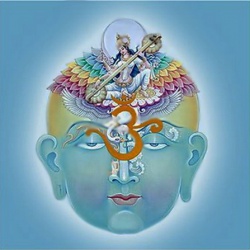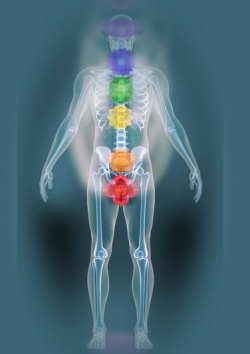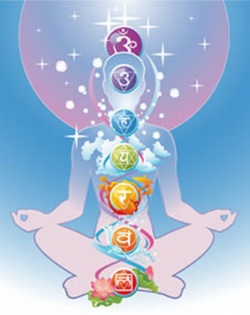The Crown Chakra
The Buddhist Chakra system is not as detailed or as complex as the Hindu Chakra system. The main purpose of the Buddhist Chakra system is to clean and purify the energy channels that relate to the 5 main wisdom energies and their corresponding neuroses. Purifying these channels acts to purify our Body, Speech, Mind, Merit, and Activity. It also works in the reverse, so that purifying our Body, Speech, Mind, Merit, and Activity will clear the channels and unblock the Chakras within our Body/Mind.
The eventual goal in the Buddhist Chakra System is to have our Body/Mind energy flow freely in the central channel and then we will experience the natural, free flow of these 5 energy aspects of ourselves. This will simultaneously generate Joy and give us the power to attain Wisdom. That is the full extent of the purpose of using Chakras in the Buddhist system. That is why it isn't very complicated.
There is one main central channel that flows down the middle of our body just in front of the spine. It is slightly opaque, sometimes said to be bluish in colour and made of light. It is said to be the size of our ring finger. On either side of this central channel are 2 side channels that are supposed to be the size of our little finger.
These 2 side channels wrap around the central channel at various places along the length of our body. These places where the side channels wrap around the central one form the various Chakras. Within each Chakra there are a set of sub-channels like nerves that branch out to various parts of our body. In total there are 72,000 sub-channels throughout the body.
There is only one head Chakra in this Chakra system. In Hindu systems, there can be 3 or more. The single Crown chakra in this system contains a 32 petalled lotus. These petals represent the major sub-channels that flow from the three main energy channels of our body at the Crown Chakra. The Crown Chakra represents our Body and Forms.
The portion of the body belonging to the Vajra family is the head and brain. The brain acts as a central repository for all kinds of information regarding the outside world and our connection with it. From the point of view of Buddhist psychology, the brain represents the secondary mind which concerns itself mostly with discursive thought.
It should be noted that the primary mind in buddhism is consciousness, which is located at the heart centre. The brain and secondary mind function in terms of analysis, storage of information, and processing of the interconnections and the organization of the information about our reality.
The head also includes the majority of the sense organs which connect to the brain. This is so that all the details about our physical world are received by the senses categorized and then stored in the brain. A beneficial practice in regards to the senses, at this point, is to pay special attention to the processes of seeing, hearing, smelling, tasting, and thinking.
The main sense and sense organ associated with the Vajra family are the eyes and sight. The focus is on seeing things clearly and completely. The emphasis in the Vajra family is on seeing all of the details of our world.
With all of the senses, it helps to become more aware of the connection between the object, the organ, and the consciousness that connects the two. Understanding Vajra family energy depends on paying close attention to the interaction of these components in the processes of seeing, hearing, smelling, tasting, and thinking.
With a visual object, all of the details have to be present in order for us to see the object itself. Next, there has to be contact with the eye and the visual object. It is very difficult to imagine what the Eiffel Tower in Paris looks like and it is very hard and takes a lot of words to describe it without a picture or without actually having seen it before.
The next aspect is consciousness. Even if an object passes within range of our eyes, there is no guarantee that we will actually see it. This is very evident when we compare one person to another. Some people see a great deal of detail right away when looking at something and are surprised that people didn't notice say, the colour or style of the shoes that someone else was wearing. Some people can very quickly see things out of the corner of their eyes that others don't notice right away. These are all examples of the role of consciousness in the process of seeing.
Another aspect of ourselves that then enters the picture is our thoughts and feelings. Once we have initially seen an object or some of its details, then we begin to categorize these details. We can also relate this object and its details to other objects. Then we develop feelings about the object being either positive, negative or neutral.
In this exercise of paying attention to the Vajra family energies, our goal is to recognize and look for the role that the object, organ, awareness, and then our thoughts and feelings, play in the function of seeing.
With hearing, we pay attention to the same processes. We feel the sensation of sound waves hitting the inner portions of our ear and feel the signals going to our brain and then we watch what thoughts and feelings that then arise based on the sound. With sound there is also an additional aspect that is harder to recognize in the process of seeing. With sound, it is easier to see the process we undergo of interpreting the sound, trying to determine what's causing it and what it means.
With smell, we feel the influx of air into our nostrils and the sensation of the smell against the inside of our nose. We may also notice the role that taste plays in the smelling process to help determine, sweet, sour, pungent, mild, etc. Again, we try to notice the process of determining what caused the smell (eg a dead skunk) and the feeling that follows (aversion?).
The same process works for tasting. Here we can also notice the role of the internal water element as well. The mixing of saliva with the food helps to categorize the taste. The taste also increases as we process the food in our mouths. Smell also helps to add to the tasting process, especially in terms of like, dislike, and indifference.
With the process of thinking,and here we mean discursive thinking, we categorize objects. We also recognize their charisteristics and relate those charisteristics to the charisteristics of other objects. We also analyze whether the object is beneficial, harmful, or neither, in regards to our goals and desires.
With all of the senses, though we are making differentiations, we tend to be very superficial in our perceptions of details. We tend to experience something just long enough to be able to categorize the object and then ignore it.
The purpose of these exercises is to begin to pay closer attention to sense objects and the process of sensing so that we ensure that we are paying attention to things when we need to. It's part of a method of ensuring complete viewpoint, complete thought, complete speech, complete action, complete livelihood, as well as complete effort, complete mindfulness, and complete concentration.
For our current purposes, it is sufficient to recognize that the main bodily location of Vajra Energy is focussed in the head and to pay attention to the aspects of the energies that move around in the head. The winds associated with Vajra energy do, however, travel throughout the body. Vajra energy, as it is expressed, links up with the other energies to form a whole picture of the object or situation.
For instance, the vajra energy which sees the details of an object will combine with the ratna energy of the navel to feel negative and have aversion towards the negative qualities of the object we are focussed on, or to feel positive and develop craving for other qualities, or to feel neutral and indifferent to qualities that are neither positive nor negative.
Awareness of the location of the energy can help identify that it is indeed Vajra energy that we are dealing with. Then we know to apply patience and remember interdependence in order to work well with our Vajra energy. Any blocking, resisting, avoiding, or grasping at vajra energy will cause tension in the head and eyes. We can also watch for areas of lack of awareness within the operation of the energy.
Some people do not connect to Vajra energy enough or at all. They can be overly emotional in the wrong situations or be unable to see the details of an object or situation and can suffer as a result.
There are two processes involved with any of these wisdom energies that we need to pay attention to. The first is to become more aware of the process of this energy and the second is to experience this energy without attachment.
We need to be able to experience these details while remaining relaxed. We also need to experience the details of an object while keeping part of our mind ready to step back and see the larger picture. We also need to remind ourselves that all the details that we notice in an object or situation and the object or situation itself depends upon causes and conditions. We must remind ourselves that the Vajra way of viewing things is only one of 5 ways of approaching any situation. Remembering these ideas is how we experience these things without being carried away, resisting, or being overwhelmed by these experiences.
By improving how we deal with Vajra energy, we will improve our brain functions, increase the keenness of our senses, and improve our relationship with our body and external forms.



